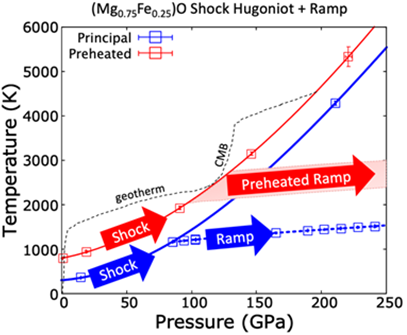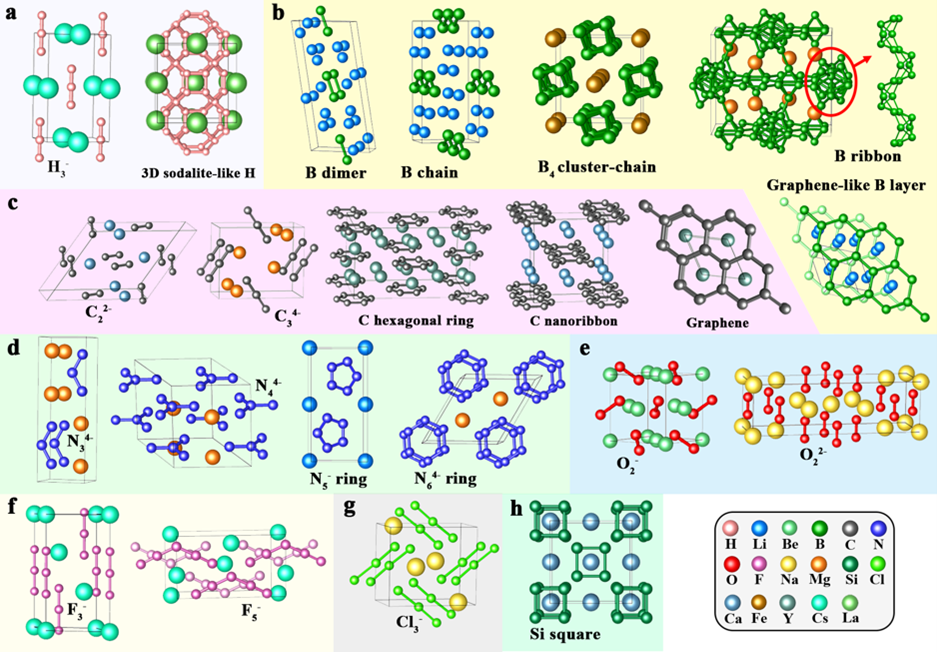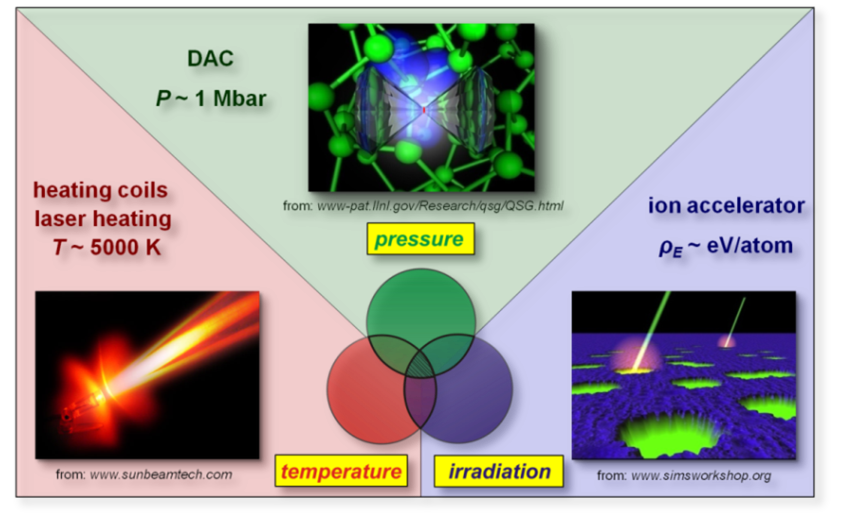SCIENCE THRUSTS
I. Thermomechanical Extremes Heading link

Goal: To enhance understanding of materials in extreme conditions by advancing the evolving synergy between static, quasi-static, and dynamic compression techniques over a broad range of strain and strain rates in close synergy with theory, modeling, and simulation.
1683. Kraus, R. G., R. J. Hemley, S. J. Ali, J. L. Belof, L. X. Benedict, J. Bernier, D. Braun, R. E. Cohen, G. W. Collins, F. Copari, M. P. Desjarlais, D. Fratanduono, S. Hamel, A. Krygier, A. Lazicki, J. McNaney, M. Millot, P. C. Myint, M. G. Newman, J. R. Rygg, D. M. Sterbentz, S. T. Stewart, L. Stixrude, D. C. Swift, C. Wehrenberg, and J. H. Eggert, Measuring the melting curve of iron at super-Earth core conditions. Science 375, 202-205 (2022).[OSTI ID 1840054]
1685. Perreault, C., L. Q. Huston, K. Burrage, S. C. Couper, L. Miyagi, E. K. Moss, J. S. Pigott, J. S. Smith, N. Velisavljevic, Y. Vohra, and B. T. Sturtevant, Strength of tantalum to 276 GPa determined by two x-ray diffraction techniques using diamond anvil cells. Journal of Applied Physics 131, 015905 (2022). [OSTI ID 1843424]
1693. Dorfman, S. M., S. Najiba, B. Arroyo, S. Theuer, M. Lv and B. L. Brugman, Control of deviatoric stress in the diamond anvil cell through thermal expansion mismatch stress in thin films. Physics and Chemistry of Minerals 49, 16 (2022). [OSTI ID 1867017]
Duwal, S., R. C. Clay III, M. D. Knudson, J. Boerner, K. Cochrane, J. Usher, D. Dolan, B. Farfan, C. de La Cruz, J. Banasek, C. T. Seagle, R. Hacking, S. Payne, C. Zoller, M. Ahart, and R. J. Hemley, Extreme compression of planetary gases: High-accuracy pressure-density measurements of hydrogen-helium mixtures above 4-fold compression. Physical Review Letters, submitted.
Clark, A.N., J.M.D. Lane, J.P. Davis, A.R. Sarafian, K.R. Cochrane, J.P. Townsend and S.D. Jacobsen. Shock-ramp of SiO2 melt. Journal of Physics Condensed Matter, in press.
II. Chemical and Material Extremes Heading link

Goal: To advance our understanding of extreme chemical and physical properties, including novel structure and bonding at high densities, extreme chemical reactivity, and exotic physical properties such as very high-temperature superconductivity and novel dielectric and magnetic phenomena.
1634. Klein, R. A., J. P. S. Walsh, S. M. Clarke, Z. Liu, E. E. Alp, W. Bi, Y. Meng, A. B. Altman, P. Chow, Y. Xiao, M. R. Norman, J. M. Rondinelli, S. D. Jacobsen, D. Puggioni and D. E. Freedman, Pressure-Induced Collapse of Magnetic Order in Jarosite. Physical Review Letters 125, 077202 (2020). OSTI ID 1650655]
1691. Wang, X., T. Bi, K. P. Hilleke, A. Lamichhane, R. J. Hemley and E. Zurek, Dilute carbon in H3S under pressure. NPJ Computational Materials 8, 87 (2022). [OSTI ID 1865713]
1707. Tamerius, A. D., A. B. Altman, M. J. Waters, E. A. Riesel, C. D. Malliakas, M .L. Whitaker, T. Yu, G. Fabbris, Y. Meng, D. Haskel, Y. Wang, S. D. Jacobsen, J. M. Rondinelli, and D. E. Freedman, Synthesis of the candidate topological compound Ni3Pb2. Journal of the American Chemical Society 144, 11943-11948 (2022).
1711. Sun, Y., L. Zhao, C. J. Pickard, R. J. Hemley, Y. Zheng and M. Miao, Chemical interactions that govern the structures of metals. Proceedings of the National Academy of Sciences USA 120, e2218405120 (2023). [OSTI ID 1925232]
1713. Hilleke, K. P. and E. Zurek, Chemistry at High Pressure. In Comprehensive Inorganic Chemistry III; Theory and Bonding of Inorganic Non-Molecular Systems. Frederickson, D. C., J. Reedijk, and K. R. Poeppelmeier, Eds. Elsevier (2023). [OSTI ID 1968603]
III. Multiple Extremes Heading link

Goal: To advance our knowledge of the behavior of materials exposed to multiple extreme environments, including intense particle and electromagnetic fields, to enhance material performance and to create new materials.
1668. Cureton, W. F., C. L. Tracy and M. Lang, Review of swift heavy ion irradiation effects in CeO2. Quantum Beam Science 5, 19 (2021). [OSTI ID 1813554]
1687. Grockowiak, A. D., M. Ahart, T. Helm, W. A. Coniglio, R. Kumar, K. Glazyrin, G. Garbarino, Y. Meng, M. Oliff, V. Williams, N. W. Ashcroft, R. J. Hemley, M. Somayazulu, and S. W. Tozer, Hot hydride superconductivity above 550 K. Frontiers in Electronic Materials: Superconductivity 2, 837561 (2022). [OSTI ID 1862863]
1703. Overstreet, C., J. Cooper, E. O’Quinn, W. Cureton, R. Palomares, J. Leys, G. Deissmann, S. Neumeier, C. Chen, and M. Lang, Structural stability of REE-PO4 (REE=Sm,Tb) under swift heavy ion irradiation. Nuclear Instruments and Methods in Physics Research B 527, 34-39 (2022). [OSTI ID 1901277]
Four Cross-cutting Themes that link the Center: Heading link
- Material Properties: Use of multiple techniques to characterize key properties materials in extreme environments.
- Targeted Materials: Investigating specific materials of fundamental and applied interest.
- Experiment and Theory: Enhancing synergies between experiment, theory, and simulation.
- Advanced Radiation Facilities: Extensive use of advanced synchrotron, neutron, laser, Z-pinch, and other facilities at DOE/SC and DOE/NNSA labs.